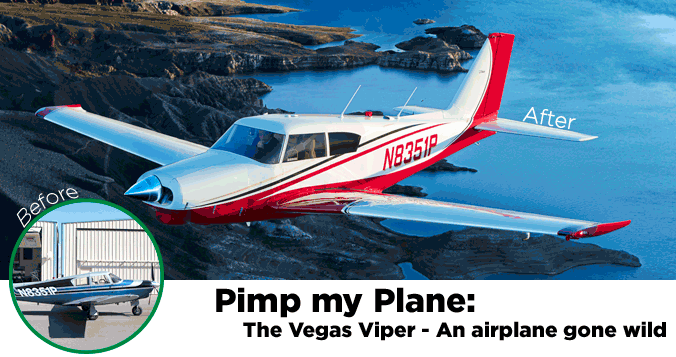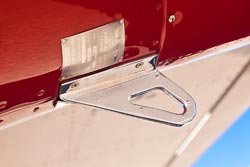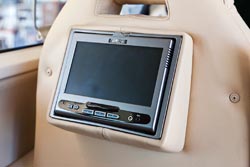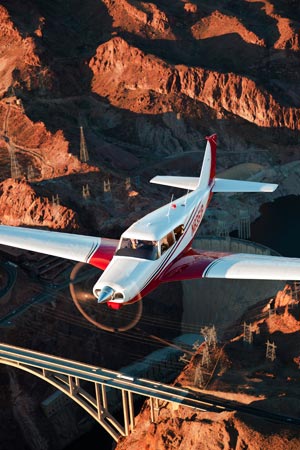
Really, it’s our fault. David Lessnick of Las Vegas was perfectly happy with his 1964 Piper Comanche 250—until he saw AOPA’s 2008 sweepstakes airplane. He paid $80,000 for the Comanche in 2005 and was quite happy with it. It was in perfect condition with a mid-time Lycoming O-540 engine. Then he went to AOPA Expo a few years ago (before the event was renamed AOPA Aviation Summit) and sat in our sweepstakes Piper Archer with its shiny glass cockpit and luxurious interior.
“I was blown away. I climbed in it, and sat in those seats, and I was like, ‘Wow, this is what it is supposed to be like,’” Lessnick said. That planted an idea that would ultimately have him chrome-plating his gas caps and custom-painting his towbar, but it would be additional months before that journey would begin. First, there was a flirtation with owning a jet—a second result of his visit to AOPA Expo that year. Cirrus and Piper salesmen he met there revived his interest in jet ownership.

Prior to the 2008 Expo, this 800-hour pilot had made a deposit on an Emivest (Swearingen) SJ30, back when deposits were $25,000 instead of $100,000, but he had withdrawn it when the Emivest company hit financial problems. Expo was like a candy store: He liked the PiperJet, was impressed with the Diamond D-Jet, but focused his dreams on the Cirrus Vision SF50.
That same year Lehman Brothers filed for Chapter 11 bankruptcy, the stock market collapsed, and overnight Lessnick’s real estate development business was affected. Suddenly, he wasn’t able to get financing for new projects. Completed projects weren’t selling for the profit he had expected, so keeping the Piper Comanche began to look like the best option.
Lessnick began to focus what he admits is his “slightly obsessive personality” on the Comanche. The battle between “want” and “need” began, with “want” in the lead. He loved the look and performance of the new, sleek, high-performance four-seat singles but couldn’t accept the $400,000 to $600,000 price tags that came with them. For $80,000, he reasoned, he could make his Comanche into a luxury aircraft with a glass cockpit. It already has a sports-car feel because of its crisp roll rate and gives him a true airspeed of between 150 and 160 knots at 9,500 feet to 14,500 feet, burning only 12 gallons per hour. But before it was over, the $80,000 budget would balloon to $104,000 as he had one good idea after another.
The ‘Vegas Viper’ makeover: Exterior ($21,050)
- Four-color custom paint scheme with Sherwin Williams Jet Glo and Acry Glo, with two coats of clear sealant
- Hand-laid stripes
- Chromed fuel caps with painted fuel compartment
- Chromed cowl latches, tiedown rings, and exterior handle
- Polished leading edge of props
- Polished spinner
- Custom-painted tow bar
- Custom laid-out wing walk
- Proseal around all windows
- All-new stainless steel hardware
- New color-matching front engine baffle
- LoPresti Speed Merchants Speed Spats
- Knots 2U wing root fairing kit
- Knots 2U wing fillet fairing kit
- Johnston Aircraft Service wing tips
- Knots 2U high intensity discharge (HID) landing
- lights (two) upgrade
- Custom-fabricated wing (rivet) patches that areunnoticeable
- Rebuilt stabilator horn assembly and trim drum
- Serviceable shimmy damper
- Integrated navigation/strobe lights
- New three-blade prop
He added a mega-annual inspection that included replacement of many parts as a precaution, since he was basically dismantling the aircraft to rebuild it. The annual turned into an airframe overhaul that came to $12,600.
 “While the overall project cost me almost 50 percent more than I had originally budgeted, I really feel I got an airplane that beat any expectations that I had by 100 percent. That’s good math in my book,” Lessnick said.
“While the overall project cost me almost 50 percent more than I had originally budgeted, I really feel I got an airplane that beat any expectations that I had by 100 percent. That’s good math in my book,” Lessnick said.
He calculates his operating cost, given that he flies 200 hours a year, at $130 per hour. That includes insurance ($2,100 per year on a hull value of $175,000), the hangar, the annual inspection, Jeppesen subscriptions, avionics upkeep, miscellaneous expenses of $2,400 per year, and variable costs that include an average $60 per hour for fuel, $15 per hour as an engine reserve, and $2 an hour for miscellaneous expenses. To get the insurance company to cover the higher value, he had to send photos of the aircraft, with invoices to prove his case, to the agent. If he were to fly only 100 hours per year, the per-hour cost rises to $183.
The airplane gained 116 pounds with all the modifications, from 1,750 up to 1,866, but it still has an honest 518-pound payload with full fuel of 90 gallons, 86 usable. All seat and cargo-area pockets are webbing instead of cloth or plastic. The webbing came from a local Mercedes Benz parts department.
“The trick is thinking through all the details, and visualizing it before you start on the project,” Lessnick said.
A head start
Before he saw the sweepstakes Archer, Lessnick did what he thought were sensible things that improved safety and performance. He upgraded from a generator to an alternator, swapped out the two-blade propeller for a three-blade propeller, and replaced the mechanical tachometer with a digital one. He ignored paint and interior upgrades because they were “wants.” He was being very practical. Yes, he was. Then he watched his favorite television show, Pimp My Ride, in which automobile owners load their cars with high-end, extraordinary embellishments. The memory of the AOPA Archer came to mind, and the dreaming began. What if he “pimped” his airplane?

Practically speaking, he didn’t need a new panel. He bought the airplane with a Garmin GNS 530 for communications and GPS navigation. It also had, when purchased in 2005, a Cobham/S-Tec System Thirty autopilot with GPS steering, and a JPI EDM-700 engine monitor with fuel-flow readout. He added a Garmin GPSMAP 696 with XM WX satellite weather and radio. He did not need a new panel, he said, but he wanted a new panel “...like a spoiled adolescent.”
Two choices for a glass panel emerged: the Aspen Avionics Evolution Pro series of products, or the Garmin G500, upgradable to synthetic vision. Aspen’s rebate caught his attention, and he liked the system—but he not only liked the G500, he “drooled” over it. The drool factor tipped the scales slightly toward Garmin. Still, he ordered and paid for the Aspen system (being practical again), then cancelled it and ordered the Garmin G500. (He still has the Garmin 530, upgraded to include WAAS.) Since he could use the JPI EDM-700 connection to upgrade to a newer model, he ordered the EDM-830, a more capable display showing fuel and battery status, oil temperature, manifold pressure, and rpm.
 “I’m a real estate developer and builder,” Lessnick said. “It was just like building a custom house. You start with a small idea—in my case it was the seats. All of a sudden you realize, if the seats look so good, now the overhead panel has to be unique. And the side panels have to be redone. And, oh, my gosh, the knob for the flaps. I can’t leave it the way it is now. And the door handle has to be changed. I can’t leave a 1954 Ford Fairlane door handle on the airplane. Every little piece of that airplane has a part of me in it, and it’s very, very unique.”
“I’m a real estate developer and builder,” Lessnick said. “It was just like building a custom house. You start with a small idea—in my case it was the seats. All of a sudden you realize, if the seats look so good, now the overhead panel has to be unique. And the side panels have to be redone. And, oh, my gosh, the knob for the flaps. I can’t leave it the way it is now. And the door handle has to be changed. I can’t leave a 1954 Ford Fairlane door handle on the airplane. Every little piece of that airplane has a part of me in it, and it’s very, very unique.”
AOPA’s interior shop
Lessnick spent 200 hours on the Internet researching the best of the best, from paint to interiors—and the best paint and interior shop to do the work. He ultimately picked Oxford Aviation in Oxford, Maine, partly because the AOPA Archer was done there. That meant he had to fly his aircraft more than 2,000 nautical miles from Nevada.
The ‘Vegas Viper’ makeover: Interior ($33,078)
- Custom-designed and hand-sewnseats from Spinneybeck leather
- Hand-cut instrument panel with silk-screen lettering
- Highest-grade wool carpeting
- Custom fabricated pilot’s seat armrest
- Custom fabricated Fiberglas over-head console with built-in oxygen and touch-adjusted LED lighting
- Gillen-phx door and trim handles withrosewood accents
- Updated side panels
- New plastic trim pieces covered in Spinneybeck leather
- Kosola and Associates retractableshoulder belts
- Custom rosewood accent pieces throughout
- Custom fabricated rear seat console with fold-down armrest and cup holders
- Polished air vent pieces
- Brushed aluminum air vents
- Headset holder straps
- Rosen Sunvisor Systems sunvisors
- Tinted quarter-inch glass all the way around
- State-of-the-art soundproofing and insulation
- Improved upper door latch system
- Updated leather-wrapped control wheels
- Leather-covered glareshield with French seam stitching
- Custom fabricated rosewood vents for Arctic Air Cooler system
- Custom fabricated fiberglass seatbacks with built-in DVD system
- All-new door seals
- Polished rudder pedals
- Custom pen and flashlight holder
Here are the highlights of what he now calls the “Vegas Viper.” (He even has water bottles with that name on it, branded water to enhance the passenger experience, but in truth they weren’t very expensive.).
Seats. The seats were stripped to the frame, and then rebuilt with multi-density foam, similar to the memory foam used in the Sealy memory-foam mattress. “I can sit in there for hours and hours and not be fatigued at all,” Lessnick said. He got the idea from a picture of the seats used in the Porsche Panamera, and sent the picture to Oxford.
The front seats of the Panamera also have a hard back, as opposed to fabric, so the designers at Oxford Aviation built a custom mold and created two Fiberglas backs with a cutout for a DVD screen. “That was my goal, my vision. I wanted to get into the best Bentley [car] with the best stitching, the best materials, and inlaid woods.”
The seats were custom made to his measurements.
Overhead panel. It is a one-of-a-kind custom design. First, a custom mold was made for a Fiberglas panel. Then, Brazilian rosewood was inlaid so that the wood grain lines up perfectly despite the angles in the panel.
DVD screens. Lessnick has twin 12-year-old daughters who like to watch movies in flight when they accompany their dad on business trips to Southern
California. The idea for the screens came from the automotive world. “We got a field approval [from the FAA] and the avionics shop made sure there was no interference with the new glass avionics I put in the airplane,” Lessnick said. A DVD player behind one of the screens plays a movie on both. The children listen through noise-canceling headsets.
Chrome everywhere. The tail tiedown, the wing tiedown rings, and the fasteners for the engine cowling are chromed. Why so much chrome?
“You know, it’s from Vegas. I want a little bling. I want something to shine a little bit,” Lessnick said. The aircraft is based at North Las Vegas Airport, but during the preparation for this article it was temporarily at Henderson Executive Airport in Henderson, a southern suburb of Las Vegas. There, chains are used to tie down aircraft. Former F–16 pilot Murray Robinson, who led the formation for air-to-air photos in this article, helped to remove them link by link to avoid damaging the chrome plating.
Vegas Viper name. Where did the name come from? “I wanted something that would stick in people’s minds. I knew this was going to be a special airplane,” Lessnick said. “I like the alliteration.”
Speed mods. His aircraft picked up several knots thanks to speed modifications for the wheel wells and re-rigging of the airplane after it was painted. Older airplanes that are out of rig lose several knots because of increased drag. The Wheel Spats smooth the airflow and reduce drag caused by retracted but somewhat exposed main-gear wheels. Wing root fairings smooth the airflow over the stabilator, and provide the pilot more control authority on landing.
 Finally, Johnston Aircraft Service wing tips were added to improve aileron authority when flying at lower speeds—OK, actually they look good and that was the primary reason.
Finally, Johnston Aircraft Service wing tips were added to improve aileron authority when flying at lower speeds—OK, actually they look good and that was the primary reason.
Soundproofing. “We put in special soundproofing,” Lessnick said. “Not only does it dampen the audible sounds, but the vibrations that come from the airplane. So the fatigue factor has been greatly reduced. I typically fly two-hour missions. But I’ve been flying more long, long cross-countries, literally like from the East Coast to the West Coast. I went to Oshkosh, I’m going to Sun ’n Fun, AOPA Summit. It is just an absolute joy to fly in now.”
“The soundproofing [uses] Oxford Aviation’s proprietary materials, the same ones we used to soundproof NOAA’s [National Oceanic and Atmospheric Administration] Hurricane Hunter,” said Jim Horowitz, president of Oxford Aviation
“Our Super Soundproofing starts with a skin dampener; lead would be great but it would be too heavy, obviously. We use an impregnated vinyl cut into an X pattern to stop the oilcanning of the skin. A three-part mix of different and unique frequency-absorbing glass and foams are sandwiched into Mylar heat-sealed packets. Each and every fuselage side, floor, and roof partition is insulated this way. We actually number them specific to the location so that they can all come out and go back in the way they were designed and built. Last, soundproofing materials are adhered to the side panels and carpeting.”
Air conditioning. It easily hits 120 degrees Fahrenheit on the ramp during most Las Vegas summers. Lessnick reconfigured an Arctic Air Cooler used by many small aircraft owners. “You’ll see what look like wooden speaker grills,” Lessnick said. “That’s not what that is. The tubes from the Arctic Air come up through there.” He has an electrical outlet in the cargo compartment where the Arctic Air unit sits, strapped down. A switch in the cockpit allows him to turn it on.
“It cools the cabin 30 degrees. It’s wonderful. If I need the extra useful load, I just take out the Arctic Air,” he said.
The ‘Vegas Viper’ makeover: Avionics ($37,350)
- Garmin G500 with synthetic vision option
- Garmin GNS 530W
- Garmin GDL 69A XM satellite receiver with XM radio and XM WX weather
- Garmin GA-55 XM WX data antenna
- Garmin GTX 330 with active traffic alerts
- Garmin GMA 340 audio panel
- Cobham/S-Tec System 30 autopilot with GPSS roll steering integrated into G500
- JPI EDM-830 digital engine monitor that displays manifold pressure, RPM, OAT, oil pressure, oil temperature, and percent of horsepower
- Precision Aviation vertical card compass
- Addition of music jacks for rear-seat passengers for separate source selection
- Updated circuit-breaker panel
Done…well, not quite
So, David, are you finished yet?
“I do need to do firewall-forward. My engine is almost at TBO. When I redo the engine I am going to put a factory-new Lycoming O-540, which is what the airplane came with. I’ll put a dual exhaust in it. I’ll have the valve rocker covers chromed. I got inspired when I went to Oshkosh. There’s always something to do.” When Lessnick showed his airplane in competition at EAA AirVenture 2010, he came home with the best-in-class trophy. When the engine work is done he will have a total investment, including the purchase price, of $228,171.

Will that complete it?
“We’re in the 99-percent ballpark right now. There are a few things I still have to do. I want to put in a [Garmin] 430 with WAAS, so I will have two. And let’s see, there’s one other thing I want to do. It escapes my mind.”
“What are the chances that you are going to find something to do after you think it is completed?” he was asked.
“Oh, I’d say 100 percent.”
E-mail the author at [email protected].



